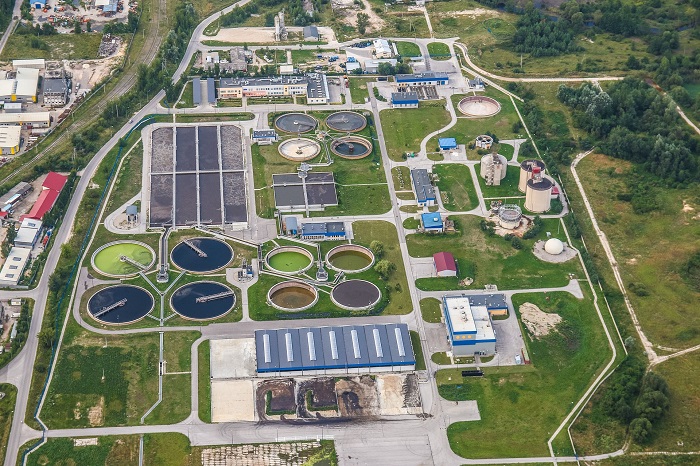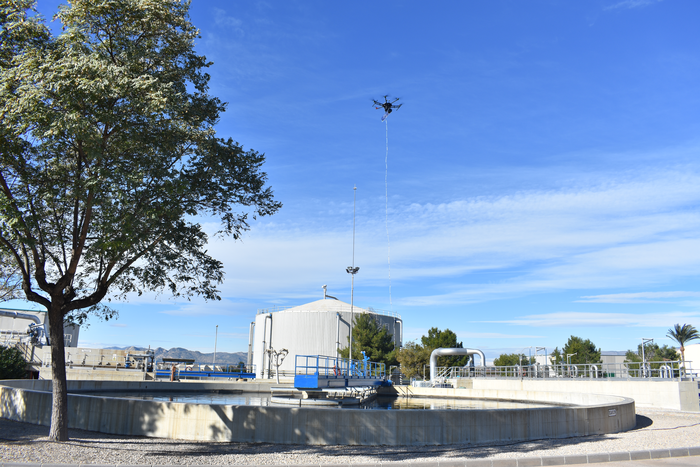ISABEL RUBIO ARROYO | Tungsteno
Scientists around the world have tried to develop electronic noses to measure the quality of organic fertilisers, detect diseases and even 'smell' a Covid 19 infection. Now a team of researchers at the Institute for Bioengineering of Catalonia (IBEC) has created an e-nose for drones that detects noxious odours coming from sewage treatment plants. The aim is to be able to predict these bad smells and thus reduce their impact on surrounding communities. We look at the potential of this technology, details of which have been published in the journal iScience.
The ordeal of living next to a treatment plant
Odours from wastewater plants are normally measured by dynamic olfactometry. First, samples of an odorous gas are collected in bags and diluted with fresh air. Then, according to the International Odour Observatory, a panel of trained people sniff the diluted odour through an olfactometer. This measurement method is discontinuous, as the samples are collected at the source at a precise time and then transported and analysed in a laboratory. "For this reason, it cannot be used to continuously monitor odour emissions," says the observatory. This process, in addition to being time-consuming and costly, does not allow for a rapid response to problems or to identify the root cause of the odour.
"I live two kilometres away from a wastewater treatment plant, and from time to time, you can't even open the window because the smell is horrendous," says Santiago Marco, lead author of the study. The researcher insists that the impact of bad odours on the quality of life of people living next to such facilities should not be underestimated.

Odours from wastewater treatment plants are often measured by dynamic olfactometry. Credit: Pixabay.
Various research studies have analysed the physical and psychological consequences of this exposure on people. The New York State Department of Health indicates that strong odours can cause some people to feel a burning sensation that leads to coughing, wheezing or other breathing problems. They may also experience headaches, dizziness or nausea. If the bad smell lasts a long time, it may affect one’s mood and stress level.
How to identify rotten eggs, urine and burnt matches
To better and continuously monitor odours from wastewater plants, IBEC researchers have designed an electronic nose that can be mounted on a drone. The device weighs 1.3 kilograms and has been trained with bags of air to identify different substances: from hydrogen sulphide to ammonia or sulphur dioxide, which smell, respectively, of rotten eggs, urine and burnt matches.
In addition to using artificial intelligence, the e-nose is equipped with a carbon dioxide sensor—an indicator of bacterial activity. In the lab, the device performed almost as well as humans. The great attraction of e-noses for monitoring environmental parameters is the ability to recognise various gases and odours with just a few sensors, as indicated by a study published in the scientific journal Sensors.
The IBEC researchers then mounted the e-nose on a drone and sent it to fly in the skies above a wastewater plant in southern Spain. The facility covers an area of 35,000 m² and serves a population of 290,000. For six months, the device sucked in air through a very thin tube about ten metres long and analysed it with a variety of sensors. "The complicated thing about measuring odour is that it is a human perception and is not well defined," explains Maria Deseada Esclapez, co-author of the study and researcher at the company Depuración de Aguas del Mediterráneo. The aim, according to the expert, was "to quantify the particular or individual components of the emission, as well as to predict the intensity of the odours perceived by humans."

For six months, the e-nose sucked in air through a very thin tube about ten metres long and analysed it with various sensors. Credit: María Deseada Esclapez.
Real-time odour mapping
The researchers found that the prototype could also monitor odours in the treatment plant in real time with high accuracy. When analysing the same air samples in a field test, 10 of the 13 measurements from the e-nose matched the assessments of the human panel. The device can measure the concentration of different odours, predict their intensity and produce a real-time odour map of the plant for management. In addition, the use of drones allowed the researchers to take measurements in dangerous and difficult to access locations.
Although the conclusions obtained are promising, it must be taken into account that so far this device has only been tested in one treatment plant. In addition, there are some limitations related to the use of dynamic olfactometry as a reference method for calibrating instruments: the high uncertainty associated with this technique is compounded by the limited number of samples that can be measured with a reasonable budget.
More research is still needed to make this flying nose more robust and to ensure that environmental conditions such as temperature, humidity and wind do not affect its accuracy. Especially since the results of this research can go far beyond wastewater treatment plants. As Marco stresses, "it could have implications for other facilities such as landfills, composting plants or even large farms with cattle and pigs, which also produce all kinds of bad odours."
· — —
Tungsteno is a journalism laboratory to scan the essence of innovation. Devised by Materia Publicaciones Científicas for Sacyr’s blog.
